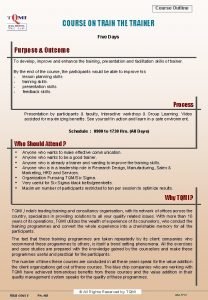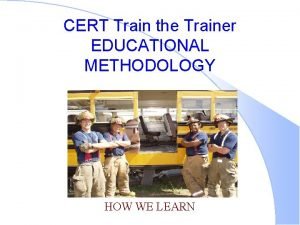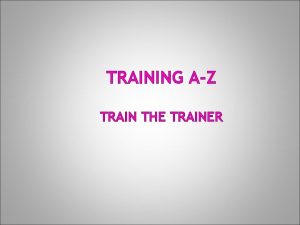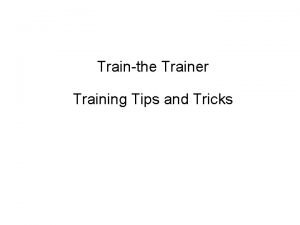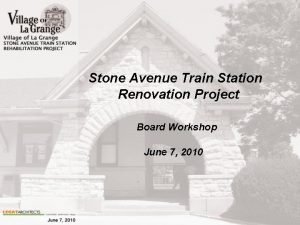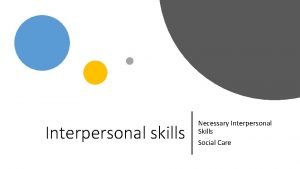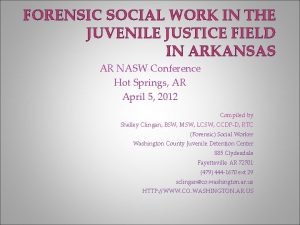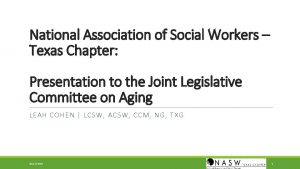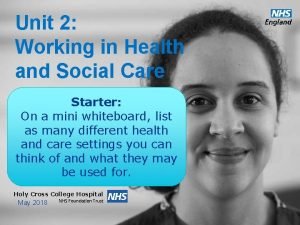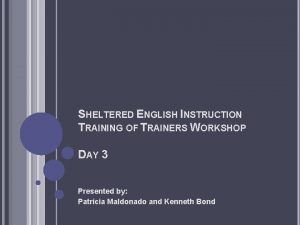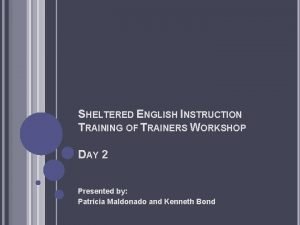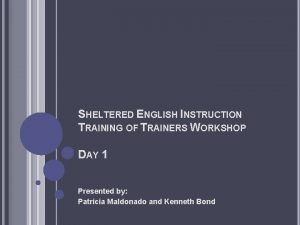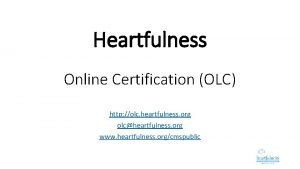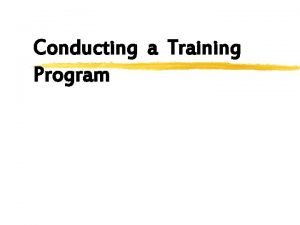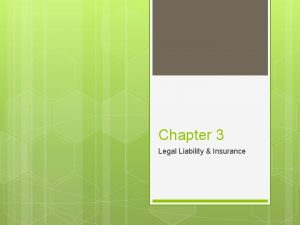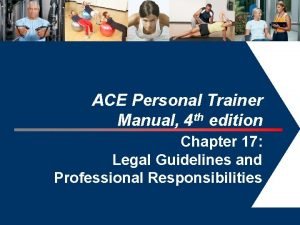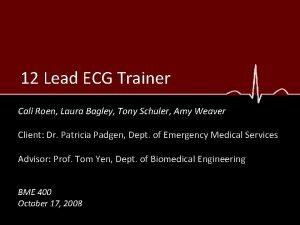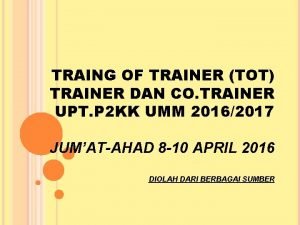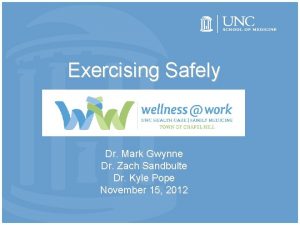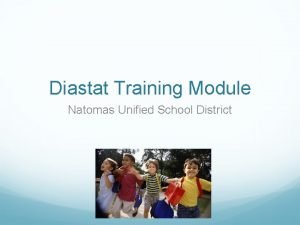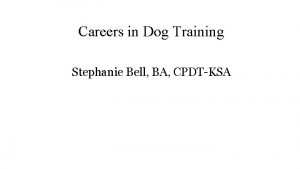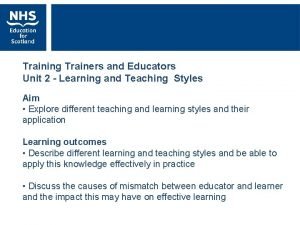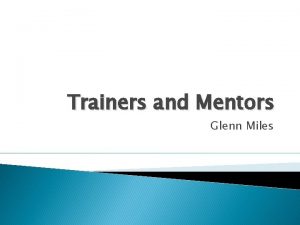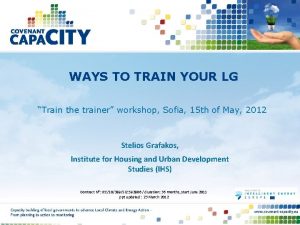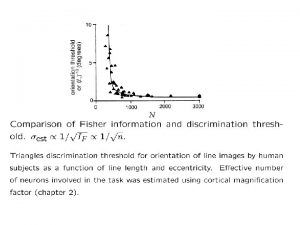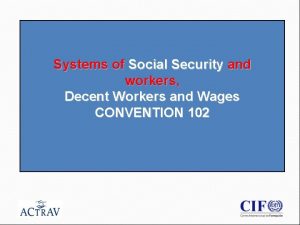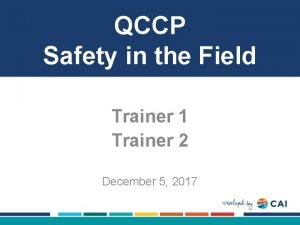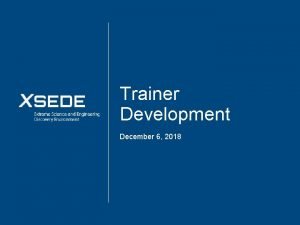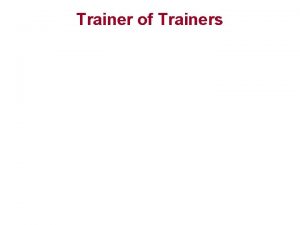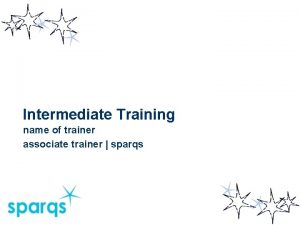Train the trainer Supporting social workers working with



























































































- Slides: 91

Train the trainer Supporting social workers working with people with care and support needs who are experiencing controlling or coercive behaviour Please. sign the registration form. Take one of the handbooks on your table and pair up with someone to discuss and complete the 10 multiple choice questions at the beginning of the book. These will be used to inform a discussion at the start of the training. Please also complete Q 1 only of the evaluation

Why are we here? 2

Controlling or Coercive Behaviour Serious Crime Act 2015 Section 76 • New legislation addressed a specific gap in the law in relation to Domestic Abuse. • Previously related criminal charges have been (and can still be) prosecuted using laws relating to individual incidents of crimes. • New crime enables a pattern of behaviour and the cumulative impact of both criminal and non-criminal behaviour to be prosecuted. • Awareness of the new crime also aims to promote understanding of the role of coercive control as the set of behaviours that entrap women (and some men) in abusive relationships. CPS (2015) Domestic Abuse Guidelines for Prosecutors Annex C 3

Where else is coercive control referred to in law? • March 2016 statutory guidance in relation to sections 42 -46 of the Care Act (2014) • April 2016 guidance in relation to section 7 of the Social Services and Well-Being Act Wales (2014) • This means that a local authority’s duty to make (or ask others to make) safeguarding enquires and determine what action is needed to protect “an adult at risk” are triggered by “reasonable cause to suspect” that an adult with health and social care needs is experiencing coercive control (where their needs prevent them from protecting themselves). Department of Health (2016) Care Act Statutory Guidance 4

What doesn't it cover? The use of coercive control in other relationships that might be referred as safeguarding concerns; for example: • Within institutions such as hospitals or care homes • By care staff working in a person’s own home • “New friends”/mate crime • Bullying at work. 5

Safeguarding Adults and Coercive Control • The statutory guidance in relation to the offence of controlling or coercive behaviour states that it should be dealt with as part of adult and/or child safeguarding and public protection procedures. • Government strategy recognises that tackling domestic abuse is a cross-departmental and multi-agency responsibility 6

Project aims Train the Trainers Skills and knowledge to develop the training Adult Social Workers Reaching a critical mass that can support adults at risk from coercive control 7

Objectives Following attendance on this training, attendees will be able to: • Describe and critically analyse models of the use of power and control in intimate relationships within a broader social context • Describe the role of coercive control within domestic abuse • Describe the key knowledge and skills that social workers will need to use in working with coercive control of people with social care needs • Describe theoretical underpinnings of intersectionality of disability, race, sexuality and other protected characteristics in relation to power and control • Use the materials on coercive control hosted on a new web resource/microsite to cascade learning and development to colleagues. • Evaluation Q 1 8

Today • Knowledge and confidence increased - coercive and controlling behaviour • Share the materials • Share experiences • Microsite • Opportunity to plan how you might use them • Find buddies 9

What this course can and can't do It can: Give you a good understanding of coercive control and what the social work response to it should look like Signpost you to further CPD materials which will support you and colleagues to practice in this area It can't: Sign attendees off as competent practitioners in delivering this training. You will need to: • Use the microsite for further reading • Link with specialist DV providers • Consider co-training with someone with more expertise (specialist trainers) 10

Understanding the dynamics of domestic abuse Quiz questions Q 1 - Is there an offence of domestic violence/abuse? 11

(Q 2) - What is Lenore Walker's 'cycle of violence'? (C) Psychologist Lenore Walker's 'Cycle of abuse' (1979) Found that many violent relationships follow a common pattern or cycle. The entire cycle may happen in one day or it may take weeks or months. It is different for every relationship and not all relationships follow the cycle— many report a constant stage of siege with little relief. • Tension building phase • Walking on eggshells/appeasing and pleasing • Acute battering episode • unpredictable and out of abusers control • The honeymoon phase • Apologies, acts of kindness, promises to change • Cycle continues over and over • May help to explain why victims stay in abusive relationships 12

(Q 3) What is the Duluth Power and Control Wheel? (B) Duluth Power & Control Wheel See workbook section 4. Theoretical model of domestic abuse Outlines the abusive and violent behaviours used by perpetrators to establish and maintain control over their partner. Very often, one or more of these violent incidents are accompanied by an array of these other types of abuse, which are less easily identifiable. 13

Criticisms: • Doesn’t show domestic abuse is situated in a broader social & cultural context • Doesn’t show agencies, organisations and culture tend not to hold perpetrators of abuse accountable • Doesn’t show we as members of society and as practitioners can be involved in re-victimising survivors of domestic abuse, (i. e. be involved in ‘secondary abuse’). 14

(Q 4) What is the extended Power and Control Wheel? (B) Cultural wheel See workbook section 4. Duluth Abuse Intervention Project The Cultural Wheel is an extended version of the Power and Control Wheel. It illustrates that domestic violence happens within personal or family type relationships, which themselves exist within larger social and cultural structures. The middle circle gives a number of social institutions and the outer lists many different aspects of culture, all of these might in some way maintain and reproduce experiences of abuse for victims. This is known as 'secondary abuse'. Importantly, changes in the different elements of the additional two circles, might also lead to challenging and eradicating domestic violence/abuse. 15

Criticism: The power and control wheels, including the extended cultural wheel, do not show sufficiently how gender can be combined with other social sources of power, such as: • • • ‘Race’ Disability Age Sexuality Immigration status etc. 16

(Q 5) What is intersectionality? (B) Intersectionality is about the interaction between two or more forms of discrimination, (for e. g. being a lesbian woman and a being disabled person. ) It is about how, racism, sexism, class, ableism etc. create layers of inequalities, vulnerabilities and dis/advantages, (for e. g. because of being black you are not listened to; and because you are being disabled you are not believed). It also about how services can create inequalities, (for e. g. a victim of DA might be helped by one service because you s/he is a disabled person, but refused a place in a DV refuge because they have a disability). Adapted from: Eileen Pittaway & Linda Bartolomei. Refugees, Race, and Gender: The Multiple Discrimination against Refugee Women 17

Intersectionality It means that if you are say: A woman & An older person & Black You are much more vulnerable to domestic (& other forms) to abuse & less likely to have access to the services and the protection that you need. 18

Situational violence Intimate terrorism Violent resistance Situation based Most extreme form of violence in an intimate relationship. Victim fights in self defence - verbally or physically No underlying dynamic of control and domination It includes Coercive Control, Might act in which produces a negative revenge/retaliation impact on a victims ability to act independently Perpetrated by both men and Generally perpetrated by women against women Violence can be severe Might fight in selfpreservation (this is when victims sometimes kill) Induces fear Continues after separation Can be frequent or infrequent Partners do not live in fear of Linked with Homicides Victim does not seek power and control 19 Types of violence (Q 6) What is domestic violence? (B) (Q 7) What is situational violence? (A) (Q 8) What is intimate terrorism? (B) (Q 9) What is violent resistance? (C)

(Q 10) Which groups of women is most likely to have experienced domestic abuse? (B) 'Losing out on both counts', Disabled women and domestic violence (2016) Dr. Ravi K. Thiara Centre for the study of safety and well-being, University of Warwick Disabled women Non-disabled women Disabled men Non-disabled men 15. 7% 7. 1% 8. 4% 4% Experienced non 11. 3% sexual partner abuse in last year 4. 9% 4. 5% 2, 5% Experienced nonsexual family abuse in last year 4. 6% 1. 7% 4. 3% 1. 4% Experienced sexual assault in last year 2. 6% 2. 2% 0. 9% 0. 7% Experienced stalking 7. 6% in last year 3. 8% 5. 3% 2. 1% Experienced any domestic abuse in last year 20

Social Model of Disability http: //www. scope. org. uk/about-us/our-brand/social-model-of-disability • Disabled people developed the social model of disability because the traditional medical model did not explain their personal experience of disability or help to develop more inclusive ways of living. • The model says that disability is caused by the way society is organised, rather than by a person’s impairment or difference. • It looks at ways of removing barriers that restrict life choices for disabled people. • Barriers are not just physical. Attitudes found in society based on prejudice or stereotype, or disablism, also disable people from having equal opportunities to be part of society. • When barriers are removed: • disabled people can be independent and equal in society, with choice and control over their own lives. 21

10 minute discussion: • Thinking about this – why do disabled people experience more abuse than non-disabled people? • What are the barriers in seeking help to end the abuse? Lydia Zijdel 22

Inequalities and barriers faced by disabled people create social entrapment • s e d u t i t At d e v e i l e • Not b ) d i l a v n (i d e u l a v Not Barri ers of ac cess › L to inf ack o orma f inte tion rprete › L ack o rs f acce ssible DA s ervice Situational/historical risk s › High levels of dependency › › › Lack Isolated Experience abuse as normal 23

When the slapping started, at first I was shocked. No boyfriend ever lifted a hand to me before. But. . . I’ve been through more than that from my doctors Rich, K. , 2014. “My Body Came Between Us” Accounts of Partner-Abused Women With Physical Disabilities. Affilia, p. 0886109914522626. 24

Domestic abuse and care and support needs 25

Domestic abuse can create care and support needs – physical health Physical impact includes disability, chronic pain, gastrointestinal, and gynaecological signs including sexuallytransmitted diseases. • Campbell, J. C. , 2002. Health consequences of intimate partner violence. The Lancet, 359(9314), pp. 1331 -1336. • NICE (2014) Domestic violence and abuse: multi-agency working Public health guideline [PH 50] National Institute for Health Excellence February 2014 https: //www. nice. org. uk/guidance/ph 50 26

Domestic abuse can create care and support needs – physical health He was extremely abusive and he put me into the hospital quite few times. The consequences on my health now [. . . ] I have had a major bone problems, and I had to have an operation on my spine, and I am questioning whether that was to do with the beatings. I’ve got arthritis and I had a lots of broken bones when he was doing this, so whether that impacted [. . . ] I’m sure that this possibly did impact up on me now [. . . ] Like now I can hardly walk, and I have to go in a wheel chair to go about (Participant 1: 63 years). I’ m waiting for a hearing aid and now [. . . ] I got severely bashed on my ear, and I’m told that I can’t hear at all in this ear, and I’ve been told that it is perforated eardrum (Participant 8: 76 years). Mc. Garry J and Simpson C (2011) Domestic abuse and older women: exploring the opportunities for service development and care delivery. The Journal of Adult Protection, 13 (6) 294 -301. 27

Domestic abuse can create care and support needs - mental health • Domestic abuse impacts negatively on Mental Health • People who experience poor mental health are more likely to have experienced domestic abuse (Trevillion et al 2012) − 70% per cent of female psychiatric inpatients and 80% of those in secure settings have histories of physical or sexual abuse − abused women are at least three times more likely to experience depression or anxiety disorders than other women − a third of all female suicide attempts and half of those by ethnic minority women can be attributed to past or current experiences of domestic abuse 28

Domestic abuse can create care and support needs - mental health 29

Domestic abuse can create care and support needs - people who misuse substances • There is a relationship between the use of drugs and alcohol and domestic abuse (Stella Project, 2004) • Some people use substances in order to manage their situation • Substance dependency can be used to create control • To cope/dull feelings • Substance misuse can create care and support needs 30

People with care and support needs experience domestic abuse • 78 -year-old Margaret Panting • Found at home of her former son in law • 5 weeks after he had removed her from sheltered housing accommodation to look after his three children • more than 100 injuries on Margaret's body • No one confessed or told the police what happened so no charges Margaret Panting died July 2001 • Domestic Violence Crimes and Victims Act 2004 Section 5 – causing or allowing the death of a child or “vulnerable adult” 31

Older Women 31% (39/ 126) of UK women killed during 2015 were over 50. Smith, KI: Counting dead women. https: //kareningalasmith. com/counting-deadwomen/ 32

National Prevalence study of Elder Abuse 2007 • 2. 6% people over 66 self-reported that they had experienced abuse in their own home in the past 12 months from friends/family or care workers • Women were more likely to say that they had experienced mistreatment than men (3. 8% of women and 1. 1% of men) • Interpersonal (physical, sexual and psychological) abuse was largely carried out by partners(57%) or other family members (37%) • 75% of perpetrators of interpersonal abuse were aged 65 -74 and 80% of them were men • The perpetrator lived in the same household in two-thirds of the cases, and in two-fifths of cases the older person was providing care for them. • Example case given by social worker where carer was being abused by the disables person - Homicide case. 33

Service responses to domestic abuse amongst older people • Domestic violence as a ‘largely hidden phenomenon’ comprising of multiple forms of harm or abuse by people who are or have been intimate partners • A lack of conceptual clarity between domestic violence and elder abuse • The complexity of family dynamics and abusive relationships • Deficit in dedicated service recognition and provision Mc. Garry et al (2014) 34

Disabled people • Women who have disabilities are at significant and higher risk of domestic abuse (Rich, 2014) • More than 50% of disabled women in the UK may have experienced domestic abuse (Magowan, P. 2004) • More disabled men experience domestic abuse than other men, with the risk to a disabled man being similar to that to women in general (PHE 2015) 35

Disabled people - Forced marriage • 12% (141 cases) of cases reported to the Forced Marriage Unit in 2015 involved people who had a physical or learning disability • 62% of were men and 38% women; • For non-disabled people only 20% of referrals are for male victims. 36

Women with learning disabilities Two small scale studies that interviewed women survivors of domestic abuse in England found that the levels of physical violence they had experienced were particularly high and of high risk (e. g. use of weapons, threats to kill) Walter-Brice, A Cox, R. , Priest, H. and Thompson, F. , 2012. What do women with learning disabilities say about their experiences of domestic abuse within the context of their intimate partner relationships? . Disability & Society, 27(4), pp. 503 -517. Mc. Carthy, M. , Hunt, S. and Milne‐Skillman, K. , 2015. ‘I Know it was Every Week, but I Can't be Sure if it was Every Day: Domestic Violence and Women with Learning Disabilities. Journal of applied research in intellectual disabilities. 37

Carers A carer is someone who ‘provides or intends to provide care for another adult’ (but not as a volunteer or contacted worker). (Care Act, 2014) “People pity him because he is taking care of you and so noble. So people are reluctant to criticise this saint or to think he could be doing these terrible things. And possibly as well as that there’s a sort of I think an idea … people don’t really ‘see’ disabled women. And people don’t easily see a disabled woman as a wife, partner, and mother. So I think for some people it’s hard to think well this might be a woman who’s being sexually or physically abused by her partner, … because disabled women don’t have sex, do they? ” 38

Domestic Abuse and Dementia; characteristic features and patterns of domestic abuse in the over 65's following the onset of dementia Knight and Hester (2014). Evidence on the issues is very scant. There is one relevant paper by Knight and Hester (2014) • They found that: • The onset of dementia was likely to lead to an escalation in the severity of the abuse, regardless of whether dementia developed in the victim or perpetrator. • The most dangerous people in their study were men with a history of being domestic violence perpetrators who had developed dementia and who had been physically abusive at some point in the past. In all of these cases, domestic abuse escalated to severe injurious from physical abuse. ’ (p 12) This was a small scale study (sample of 22 case records) so findings should be read with caution - but it raises important considerations for practice, especially around how practitioners make safe enquiries and overcome assumptions about who experiences domestic abuse. Older women themselves have highlighted the importance of raising awareness and providing information (Mc. Garry and Simpson, 2011), and health and social care practitioners have an important role to play in this • Knight and Hester (2014). 39

40

ts rea Th pla of ys da tio n to po tal we r on ted lati tor es ctiv spe Dis per Power & Control l na sio ces n ca Oc ulge ind De gra Dis En fo tri rced de vial ma nd s ty & i l i ab on Dis austi exh Iso Systematic misuse of power 41 Adapted from Biderman et al (1957) by Hammersmith and Fulham DA partnership and Leeds Inter-Agency (1992) Project as inspired by Duluth Abuse Intervention Project

Group work Identify strategies of abuse from the part of the wheel allocated to your group How might coercive control be experienced by people with care and support needs? See workbook section 6 and 7. 42

Controlling and coercive behaviour: what is it? 43

Evan Stark • Susan Schechter coined the term "coercive control“ in the 1980's • Schechter argued that the end of abuse in a relationship is not when the abuser stops physically assaulting a woman - he must also be able to ‘relate in non- coercive ways’. (WOMEN AND MALE VIOLENCE: THE VISIONS AND STRUGGLES OF THE BATTERED WOMEN'S MOVEMENT 317 -319, 1982) • Coercion was conceptualised in psychological fields – Albert Bideman • More recently, Evan Stark expanded upon Schechter's "coercive control“ model of domestic violence • Coercive control is a condition of entrapment that can be hostage-like in the harms it inflicts on dignity, liberty, autonomy and personhood as well as to physical and psychological integrity. • ‘A strategic course of conduct in which violence, sexual coercion, intimidation, isolation and control are used to dominate and exploit a partner and deprive her of basic rights and resources. ’ 44

Professor Evan Stark - Coercive Control 45

The Four major tactics of coercive control - Evan Stark Physical/ Sexual Violence Isolation Degradation Intimidation & Stalking Control

Further Sub tactics 1. Communication - control her channels of communication, going through drawers, diary, phones. 2. Surveillance - monitoring time, mileage, turning up at work, attending all appointments 3. Degradation - degrading insults, denying self respect 4. Sexual control - when, how, where, withholding or rape, threats to get elsewhere Micromanaging ‘crushes the spirit even more fundamentally than the deprivation of basic necessities because it leaves little space for a person to breathe’. (Stark. E, 2007. P. 272) Ownership - Marking Tattoos, bite marks, burns, facial scars – marks ‘ownership’ and can become a source of self loathing. 47

Home Office guidance: Aide memoire to identify coercion • Does he control her channels of communication, going through drawers, diary, phones, • Evidence of surveillance and micromanagement • Does she appear unable to think and act freely • Anxiety when routine activities are changed • Does he turn up at work, get people to spy on her, report back • Control food, self care activities • Any evidence of shame tactics (you could ask if there is anything he will use against her) • Evidence of marking, scars etc • Evidence extreme isolation (imprisonment) • Damage to personal pride • Fractured relationships with family and friends 48

Coercive and Controlling Behaviour The Process Conditioning Dependence Entrapment 49

6. Ending the abuse Liz Kelly identifies 6 stages…. 5. Ending the relationship Not a sequence! 4. Re-evaluation of the relationship 3. Defining abuse 2. Distortion of perspective/ reality 1. Managing the situation 50

Section 76 The offence “repeatedly or continuously; ” had a “serious effect” on the victim; - Meaning it caused the victim to fear that violence would be used against them on “at least two occasions”, or it has had a “substantial adverse effect on their day to day activities” AND The alleged perpetrator must have known that their behaviour would have a serious effect on the victim, or the behaviour must have been such that he or she “ought to have known” it would have that effect. 51

What does serious effect mean? The behaviour has had a substantial effect on them if it has caused them to change the way they live. • For example, they may have changed the way they socialise, their physical or mental health may have deteriorated, they may have changed the way they do household chores or how they care for their children. • If they have changed the way they live in order to keep them or their children safe from harm, it is possible that the behaviour they are experiencing is coercive control 52

The Care Act relates wellbeing to the following areas: Links directly to 'serious effect' • • • Physical and mental health and emotional wellbeing Participation in work, education, recreation etc. Social and economic wellbeing Domestic, family and personal relationships Suitability of living accommodation Contribution to society Personal dignity Protection from abuse and neglect Control by the individual over day to day life 53

Types of evidence required for prosecution Supporting people to understand You are not investigators but knowing what is required helps. • Copies of emails; • Phone records; - landline and mobile • Text messages; • Evidence of abuse over the internet, digital technology and social media platforms; • Evidence of an assault - injuries on body • 999 tapes or transcripts; • CCTV; 54

Types of evidence continued • Records of interaction with services such as support services, medical records; • Witness testimony (family and friends of the victim may be able to give evidence about the effect and impact of isolation of the victim from them) • Bank records to show financial control; Where the perpetrator has a carer responsibility, the care plan might be useful as it details what funds should be used for • Medical records • Previous threats made to children or other family members; • Diary • Evidence of isolation such as lack of contact between family and friends, victim withdrawing from activities such as clubs, support groups, perpetrator accompanying victim to medical appointments. 55

Recording Controlling or Coercive behaviour • Record the abusive behaviour and then the impact that is had/or is having on the person • • • Have they changed their routine, diet, medication, given up work? Are they experiencing insomnia, depression, anxiety? Record demeanour Never use blaming language Always write 'verbatim' Professional judgement is important 56

Services can assist by supporting the victim to: • Engage with specialist services that will support the criminal justice process (if wanted) • Provide service records, case records and records • Contact helplines which may act as evidence for the offence. • Obtain case notes from mental health or drug and alcohol services which may provide evidence. • Obtain any evidence from housing services of anti social behaviour, damage to property, complaints from other tenants 57

Defence Advocates/Barristers can use records in defence in court. Make sure that what you write cannot be misinterpreted. • • • A was being difficult A refused medication A refused support with personal care A refused to engage with the service A was colluding 58

What you can do • Be aware of CCB • Ask the right questions • Record accurately • Listen to what is being said • Support 59

60

Professional competence Intervention and skills • Social workers engage with individuals, families, groups and communities, working alongside people to assess and intervene • They enable effective relationships and are effective communicators, using appropriate skills. Using their professional judgement, they employ a range of interventions: promoting independence, providing support and protection, taking preventative action and ensuring safety whilst balancing rights and risks • They understand take account of differentials in power, and are able to use authority appropriately BASW Professional Capabilities Framework 61

Safeguarding under the Care Act 2014 • Reasonable cause to suspect that an adult is an “adult at risk” • the local authority must make (or cause to be made) whatever enquiries it thinks necessary to enable it to decide whether any action should be taken in the adult’s case and, if so, what and by whom • Wellbeing principle: “Everyone involved in an enquiry must focus on improving the adult’s well-being and work together to that shared aim” • Presumption of mental capacity • Duty to consider whether an independent advocate is required 62

Making Safeguarding Personal Safeguarding is: • Person-led • Outcome-focused • Enhances involvement, choice and control • Improves quality of life, wellbeing and safety • Strengths based (Care Act Guidance) lga. org. uk 63

What do people at risk from domestic abuse want? • Contact with others, Friendship and mutual support • Proactive asking about abuse • Quality time and the opportunity to talk • Acceptance and understanding/no blame • Encouragement • Recognition of risks/prioritising safety • Practical support and assistance (Humphreys and Thiara (2003), Abrahams (2007)). 64

Safeguarding practice If the situation may be one of coercive control – learning from best practice re-domestic abuse Concern /referral Decision -Section 42 enquiry? Strategy How best to make safe enquiry? Enquiry Safe enquiry Protection plan Risk assessment Involve other/specialist agencies Use advocates Safety Plan DASH-RIC CCUK Women’s Aid, Freedom Program IDVA’s/ISVA’s Review/Outcomes? 65

Activity - consider the vignette you have been given How would you make a safe enquiry with the person(s) in the case study? How will you meet with her/him? Where would you consider meeting? How will you contact her/him to arrange a meeting? 66

Safe enquiry • Safe enquiry means ensuring the potential perpetrator is not and will not easily become aware of the enquiry • Ensure the best person to asks – use the multi-agency “team” (with support if needed) Explaining the limits of confidentiality • The only time I would tell anyone anything you told me would be if a child was in danger, if another adult was in serious danger or if a crime may have been committed. Even then, I would discuss it with you first if I could and I would do everything I could to support you or • From what you have told me I believe that you are at risk of serious harm (MARAC) 67

Ensure safety and confidentiality • Always ensure you are alone with the person before enquiring into possible abuse - never ask in front of a partner, friend or child • Make sure that you can’t be interrupted, and that you – and the person – have sufficient time • Only use professional interpreters and advocates (IMCA/IDVA/DAPA) • Do not pursue an enquiry if the person lacks capacity to consent to the interview unless you have already arranged an advocate • Record! (but not in client/patient held records or organisational systems to which the perpetrator may have access) 68

Who is the perpetrator? • Situational violence? Coercive control? Retaliatory violence? • How might a perpetrator of Coercive Control respond to Safeguarding interventions? • Notice and record their response to you 69

Risk assessments Are based on combination of Likelihood of the event occurring Level of harm caused 1 2 3 1 1 2 3 2 2 4 6 3 3 6 9 Purpose? Understanding/safety/evidence Whose safety? Adult at risk/worker/organisation? 70

Assessing risk: Using risk assessment tools and exercising professional judgement • Risk assessment should draw on multiple forms of information and evidence about the perpetrators background, any prior incidents of domestic abuse, and take into account the evidence of the person experiencing the abuse, their level of fear, and any coercive control and psychological abuse • It is important to remember that risk can be fluid and circumstance can change suddenly • Ensure that the safety plan includes a way for the person at risk to let professionals know if they think the risk level has increased • When properly used, the tools should lead to robust risk management that protects and promotes the safety and well-being of the people affected by the abuse 71

Assessing risk: involving the person at risk • Involving the person at risk, and/or a trusted advocate or IMCA (if the person lacks capacity) in the risk assessment is more likely to: • produce an accurate, comprehensive and better-evidenced risk assessment • give the person themselves, or someone on their behalf, an opportunity and support to identify, describe and understand the risks for themselves, keeping their wishes central to the safeguarding • Survivors have been found to make accurate assessments of the level of risk they face and understand the potential consequences of taking action – for example to leave a relationship (which has been evidenced to be a time of high risk to the survivor and her children) Cattaneo, L. B. , Bell, M. E. , Goodman, L. A. , & Dutton, M. A. (2007) Intimate partner violence victims’ accuracy in assessing their risk of re-abuse. Journal of Family Violence, 22, 429– 440. Pain, R. , 2014. Everyday terrorism Connecting domestic violence and global terrorism. Progress in Human Geography, 38(4), pp. 531 -550. 72

Domestic Violence Disclosure Scheme (Clare’s law) • Under the Domestic Violence Disclosure Scheme (‘Clare’s Law’), a person who is experiencing domestic abuse has a ‘right to ask’ - this enables them to ask the police about a partner’s previous history of domestic abuse or violent acts. Police can proactively disclose information about a previous perpetrator of domestic abuse to a current partner in prescribed circumstances 73

Child protection • 62% of Children exposed to domestic abuse are directly harmed • Amongst other impacts, over half (52%) had behavioural problems, over a third (39%) had difficulties adjusting at school, and nearly two thirds (60%) felt responsible for negative events CAADA -Safe. Lives 2014 74

Mental capacity and coercion Coercive control Mental Disorder Unwise decisions 75

IMCAs http: //www. justice. gov. uk/downloads/protecting-the-vulnerable/mca/making-decisions-opg 606 -1207. pdf • Independent Mental Capacity Advocate must be used when…… § Person does not have capacity in relation to making relevant decision/s about a serious medical condition or where they will live AND they are “unbefriended” can be used when…… § Person does not have capacity in relation to making relevant decision/s about their safety from abuse § Whether or not they are “befriended”/have relatives who say they can speak for the person 76

Inherent jurisdiction of the High Court • To cover gaps in the law • Safeguard people who do not lack capacity, but their ability to make decisions has been compromised because of coercion, undue influence or constraints on their circumstances • Make orders to enable a person to make a free and informed decision 77

Mental capacity and coercion “in my judgment… the inherent jurisdiction can be exercised in relation to a vulnerable adult who, even if not incapacitated by mental disorder or mental illness, is, or is reasonably believed to be, either (i) under constraint or (ii) subject to coercion or undue influence or (iii) for some other reason deprived of the capacity to make the relevant decision, or disabled from making a free choice, or incapacitated or disabled from giving or expressing a real and genuine consent. ” Per Munby J in A Local Authority v (1) MA (2) NA and (3) SA [2005] EWHC 2942, at paragraph 77 The local authority sought to invoke the court’s inherent jurisdiction to protect the parents whom it claimed lacked capacity as a result of duress and undue influence brought to bear by DL. The family court judge granted an interim injunction, restraining his behaviour towards his parents, care staff and other professionals, under the court’s inherent jurisdiction in respect of his mother and under section 48 of the Mental Capacity Act 2005 in respect of his father. DL v A Local Authority & Others [2012] EWCA Civ 253 High Court Judgement upheld the decision 78

Inherent jurisdiction of the High Court • Consult your manager and gain legal advice • Work with people used to making applications to Co. P (BIAs/Do. LS workers? ) • Careful documentation as to why you believe i) the person has mental capacity ii) isn’t able to make a capacitated decision due to their circumstances (the abuse) 79

Virtual team/safeguarding meetings • If you like we can get everyone who might be able to help together……. with you Chair exercise class Community centre Elders group District Nurse Gurdwara Neighbourhood manager Social Housing Provider Accident and Emergency GP Police Specialist DV worker Social Worker 80

Outcomes - safety planning? The foundation stones of a new life • Having opportunities to explore domestic violence and its legacies through counselling, but also with trusted family and friends; • Being and feeling safe; • Being settled and able to make a new home; • Improved health/ability to manage health conditions; • Children in new schools and less anxious, able to make and see friends, safe child contact; • (Re)entering employment and/or education and training; • A tight, but trusted, network of family and friends; and • Financial security Kelly et al http: //solacewomensaid. org/wp-content/uploads/2014/06/SWA-Finding-Costs-of-Freedom-Report. pdf 81

Safety planning Using the case study on your table Using the cards as prompts build a safety/protection plan for the person at risk Which agencies would be involved, what would their role be? what information would they need about the risk of abuse? See section 9 and 10 of the workbook for guidance on safety planning. 82

6. Ending the abuse Liz Kelly identifies 6 stages…. 5. Ending the relationship Not a sequence! 4. Re-evaluation of the relationship 3. Defining abuse 2. Distortion of perspective/ reality 1. Managing the situation 83

Successful interventions with perpetrators of domestic abuse Changing the balance of power • Arrest can work to prevent reoffending • Injunctions or restraining orders can prevent continued harassment Choosing to stop • Risk can be decreased by attending professionally-run specialist group programmes http: //respect. uk. net/ • work from the assumption that perpetrators gain from controlling their partners and intentionally use their behaviour to control their partner/can become self-aware as to how they do this https: //www. dur. ac. uk/criva/projectmirabal/ 84

Duty to perpetrators with care and support needs • Some adults with care and support needs may be perpetrators of domestic abuse E. g. Men who are living with dementia who have been perpetrators of domestic abuse earlier in their married lives continue to abuse and may increase the level of violence they use against their wives after the onset of dementia. Knight L and Hester M (2014) Domestic abuse and dementia. What are the characteristic features and patterns of longstanding domestic abuse following the onset of dementia? ’ Safe (Winter 2014) 10 -14. 85

Duty to perpetrators with care and support needs • Specialist training should be undertaken before assessing perpetrators of domestic abuse or providing interventions to address abusive behaviour • If you are working with a perpetrator of coercive control ensure the person at risk receives confidential support • Ensure professionals working with the perpetrator and those working with the victim are part of a ‘virtual team’ and are actively sharing information relevant to risk to the survivor • Ensure risk to others is considered when providing care and support to perpetrators 86

Break 87

Introduction to the resources website 88 http: //coercivecontrol. ripfa. org. uk/

Planning and reflection • What activities do you plan to deliver, and to whom? • How can you involve people with specialist knowledge of domestic abuse in your CPD activities? • What might the challenges of your training/ CPD sessions be? • How will you integrate survivors’ voices? See workbook section 11 89

Final questions and feedback Evaluation • Please complete your evaluation form on both sides. 90

Contact and further information • http: //coercivecontrol. ripfa. org. uk/ • www. ripfa. org. uk • www. womensaid. org. uk 91
 Train the trainer course objectives
Train the trainer course objectives Train the trainer outline
Train the trainer outline Cert train the trainer
Cert train the trainer Train the trainer agenda
Train the trainer agenda Trainthe trainer
Trainthe trainer Stone avenue train station
Stone avenue train station Smart vs hard working
Smart vs hard working Cold working disadvantages
Cold working disadvantages Hot working and cold working difference
Hot working and cold working difference Machining operations
Machining operations Pembentukan plat pada pengerjaan panas
Pembentukan plat pada pengerjaan panas Micro system social work
Micro system social work Social work assessment questions for clients
Social work assessment questions for clients Social work interpersonal skills
Social work interpersonal skills National organization of forensic social work
National organization of forensic social work National association of social workers texas
National association of social workers texas Apa itu social thinking
Apa itu social thinking Social thinking social influence social relations
Social thinking social influence social relations Health and social care unit 2
Health and social care unit 2 Unit 2 working in health and social care
Unit 2 working in health and social care Hát kết hợp bộ gõ cơ thể
Hát kết hợp bộ gõ cơ thể Ng-html
Ng-html Bổ thể
Bổ thể Tỉ lệ cơ thể trẻ em
Tỉ lệ cơ thể trẻ em Voi kéo gỗ như thế nào
Voi kéo gỗ như thế nào Tư thế worm breton là gì
Tư thế worm breton là gì Chúa yêu trần thế alleluia
Chúa yêu trần thế alleluia Kể tên các môn thể thao
Kể tên các môn thể thao Thế nào là hệ số cao nhất
Thế nào là hệ số cao nhất Các châu lục và đại dương trên thế giới
Các châu lục và đại dương trên thế giới Công thức tính thế năng
Công thức tính thế năng Trời xanh đây là của chúng ta thể thơ
Trời xanh đây là của chúng ta thể thơ Cách giải mật thư tọa độ
Cách giải mật thư tọa độ 101012 bằng
101012 bằng Phản ứng thế ankan
Phản ứng thế ankan Các châu lục và đại dương trên thế giới
Các châu lục và đại dương trên thế giới Thơ thất ngôn tứ tuyệt đường luật
Thơ thất ngôn tứ tuyệt đường luật Quá trình desamine hóa có thể tạo ra
Quá trình desamine hóa có thể tạo ra Một số thể thơ truyền thống
Một số thể thơ truyền thống Cái miệng nó xinh thế
Cái miệng nó xinh thế Vẽ hình chiếu vuông góc của vật thể sau
Vẽ hình chiếu vuông góc của vật thể sau Thế nào là sự mỏi cơ
Thế nào là sự mỏi cơ đặc điểm cơ thể của người tối cổ
đặc điểm cơ thể của người tối cổ V cc cc
V cc cc Vẽ hình chiếu đứng bằng cạnh của vật thể
Vẽ hình chiếu đứng bằng cạnh của vật thể Vẽ hình chiếu vuông góc của vật thể sau
Vẽ hình chiếu vuông góc của vật thể sau Thẻ vin
Thẻ vin đại từ thay thế
đại từ thay thế điện thế nghỉ
điện thế nghỉ Tư thế ngồi viết
Tư thế ngồi viết Diễn thế sinh thái là
Diễn thế sinh thái là Các loại đột biến cấu trúc nhiễm sắc thể
Các loại đột biến cấu trúc nhiễm sắc thể Các số nguyên tố là gì
Các số nguyên tố là gì Tư thế ngồi viết
Tư thế ngồi viết Lời thề hippocrates
Lời thề hippocrates Thiếu nhi thế giới liên hoan
Thiếu nhi thế giới liên hoan ưu thế lai là gì
ưu thế lai là gì Khi nào hổ mẹ dạy hổ con săn mồi
Khi nào hổ mẹ dạy hổ con săn mồi Khi nào hổ mẹ dạy hổ con săn mồi
Khi nào hổ mẹ dạy hổ con săn mồi Sơ đồ cơ thể người
Sơ đồ cơ thể người Từ ngữ thể hiện lòng nhân hậu
Từ ngữ thể hiện lòng nhân hậu Thế nào là mạng điện lắp đặt kiểu nổi
Thế nào là mạng điện lắp đặt kiểu nổi How to be a good trainer
How to be a good trainer Luke trainer clark the boy who cried wolf
Luke trainer clark the boy who cried wolf Sheltered trainers
Sheltered trainers Sheltered 2 trainer
Sheltered 2 trainer Sheltered trainers
Sheltered trainers Cisco certified instructor
Cisco certified instructor Portal 2 trainer
Portal 2 trainer Become a microsoft certified trainer
Become a microsoft certified trainer Azure certification poster
Azure certification poster Heartfulness preceptor training
Heartfulness preceptor training Good trainer qualities
Good trainer qualities Example of malfeasance in athletic training
Example of malfeasance in athletic training Ace personal trainer insurance
Ace personal trainer insurance 12 lead trainer
12 lead trainer Underwater escape room
Underwater escape room Sce trainer package v17
Sce trainer package v17 Microsoft innovative educator trainer academy
Microsoft innovative educator trainer academy Executive team trainer
Executive team trainer Tot mc
Tot mc Globe trainer
Globe trainer Zach morgan trainer
Zach morgan trainer Diastat trainer
Diastat trainer Self-employed dog trainer salary
Self-employed dog trainer salary Sheltered 2 trainer
Sheltered 2 trainer Qualities of a good trainer
Qualities of a good trainer Nebuchadnezzar trainer
Nebuchadnezzar trainer Trainer profile
Trainer profile Trainer profile
Trainer profile The messenger trainer
The messenger trainer Step trainer
Step trainer

